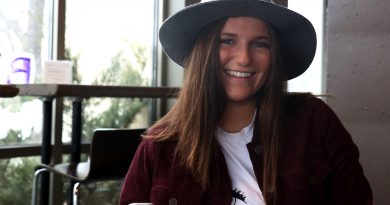The creativity gap: An art student reflects on lacking resources in a rural high school
Whenever anyone had a question about art in her high school, in the small town of Reedsburg, Wisconsin, teachers and students always called on Rachel Anderson.
“Growing up when you have so few kids at your school, you have one or a couple of people who are really good artists and no one around school is making art,” said Anderson, who is now a graphic design Junior at the University of Minnesota Twin Cities. “You’d have student council say, ‘Go ask Rachel! She’s really good at art!’”
While flattering, such status was also a reminder that her ceiling was too low at the time. Anderson’s small-town high school did what it could, but lacked the resources to apply to arts education. When she arrived at the University of Minnesota campus, this became especially apparent in contrast with the ample resources that were at her peers’ disposal.
Anderson’s situation illustrates the problems that rural counties face due to lack of funding and plummeting enrollment numbers, creating a harsh reality of having to do more with less. To cope, some districts have turned to four-day school weeks to save money, particularly on things like utility and transportation costs.
“It started as a money-saving device,” said Sherri Broderius, the superintendent of MACCRAY school district. But over time, she said, it’s presented an increased opportunity to focus on academics and arts education—both performing and visual.
To meet Minnesota state requirements with fewer school days, the MACCRAY district required longer hours— but in the visual arts department, the extra minutes count. The four-day week allows more time for students to work on their art projects, with less time spent taking things out and putting them away.
Anderson’s district in Wisconsin had more art education opportunities than most small towns, and it fulfilled the state’s requirement that it offer both music and art to students. But, she said, it still wasn’t ideal.
Her school, Reedsburg High, currently offers five art courses ranging from art foundations to ceramics, as well as three advanced level art courses. Often, however, students were just placed in those classes to fulfill a credit requirement.
“Reedsburg art classes were not filled with a lot of kids who actually liked art and were kind of just there to mess around and be in a class,” Anderson said.
Anderson took all the art classes that she possibly could, but because she wanted to prepare for a four-year college, she could only fit in three of the five offered throughout her high school career.

But an hour south of Reedsburg, in Madison, Wisconsin, the art departments at all three high schools in the area are overwhelmingly providing their students with more art classes. West High School offers 25 different art courses, James Madison Memorial High offers 24 and La Follette high school offers 16.
According to the Arts Education Data Project, a state project supporting arts education, Wisconsin schools are required to offer both music and art. The project found 91 percent of students had access to both, at least as of 2016. But that means 72,726 students have not.
“I kind of wish I could have had more out of it,” Anderson said of the art classes.
Reedsburg High would occasionally host art competitions, but a lack of student interest meantart teachers had to recruit students to compete.
Anderson said not having those opportunities impacted her initial experience at the university. She sometimes felt like she wasn’t as good as her peers when it came to her art.
“That was one of the first things I remember telling my mom. I came back from break and told her, ‘there are these people in my drawing class that are actually good at drawing.’” she said.
Anderson felt she was behind in her art knowledge that she received in high school. The courses that were available at her high school lacked curricular depth.
“There was really no curriculum on the weight of pencils from H to B and when you should use those and things you need for shading and dimensions and things like that,” Anderson said of her high school art experience.
Her art assignments consisted of simple tasks like drawing her name in funky lettering or sketching a dog.
But despite not having an extensive exposure to the arts in high school, Anderson’s passion for art led her to pursue it further once she left her hometown.
Anderson is graduating a semester early and, while taking courses, she’s a graphic design intern for Lutheran Social Service. She hopes to move out of the Midwest and pursue a career in book design.
“It was kind of something that I’d always wanted to do because I’ve always been super artistic,” she said. “Coming to college for art has been a really cool, eye opening experience and a bunch of different opportunities.”


